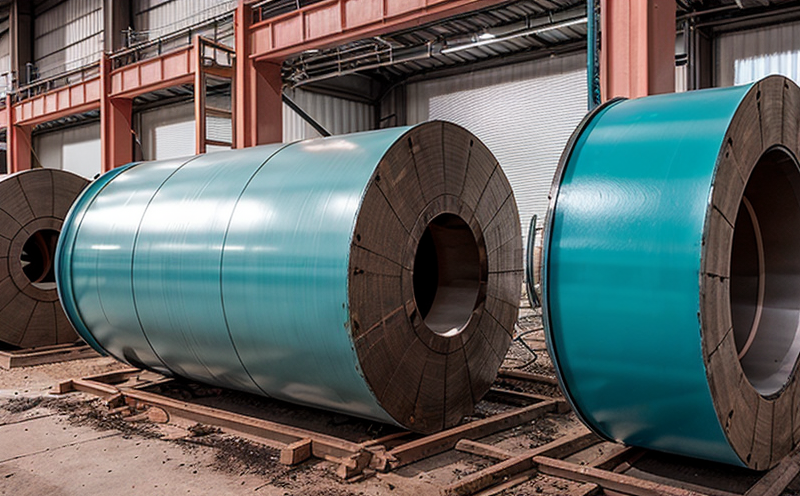ASTM D5894 Cyclic Salt Fog and UV Corrosion Testing
The ASTM D5894 cyclic salt fog and ultraviolet (UV) corrosion testing is a critical method used to evaluate the resistance of materials, coatings, and finishes against environmental stressors. This test is particularly valuable in industrial manufacturing and processing sectors where products are exposed to harsh conditions such as marine environments, coastal facilities, or industrial operations involving corrosive chemicals.
The ASTM D5894 protocol involves a series of exposures to alternating salt fog and UV radiation, simulating the real-world environmental conditions that materials may encounter. This cyclic exposure is designed to accelerate aging processes and reveal potential weaknesses in material durability over time.
During this testing process, specimens are exposed to a controlled environment where they undergo repeated cycles of high humidity followed by high temperatures with salt fog and UV radiation. The goal is to assess the performance of materials under conditions that can lead to corrosion or degradation. This method ensures that manufacturers can evaluate their products' integrity before they reach the end-user.
The cyclic nature of this test allows for a more comprehensive evaluation than static exposure methods, providing insights into the long-term behavior and stability of materials in challenging environments. By simulating real-world conditions, ASTM D5894 helps to ensure that industrial products meet stringent quality standards and perform reliably under harsh environmental stressors.
The testing process involves precise control over temperature, humidity levels, salt concentration, and UV intensity, all of which are critical factors influencing the outcome of the test. Specimens undergo these controlled conditions in a cyclic manner, ensuring that they experience realistic environmental stresses without undergoing actual field exposure.
By understanding how materials behave under such conditions, manufacturers can make informed decisions about material selection, coating application techniques, and product design. This testing method is essential for industries where reliability and performance are paramount, especially those dealing with outdoor equipment, marine structures, or industrial facilities located in corrosive environments.
Scope and Methodology
| Aspect | Description |
|---|---|
| Test Specimens | The specimens must be representative of the materials to be tested, typically in the form of coupons or parts that are exposed to the environment. |
| Environmental Conditions | Temperature ranges from 35°C to 60°C, humidity levels up to 100%, salt fog concentration of 5% NaCl, and UV radiation equivalent to a clear sky condition at noon. |
| Cyclic Exposures | The specimens are exposed to alternating cycles of high humidity with salt fog followed by exposure to UV radiation. Each cycle lasts for 16 hours. |
| Testing Duration | The test can be run up to 480 hours, depending on the material's expected service life and desired level of confidence in its performance. |
| Data Collection | Measurements are taken regularly to track changes in weight, appearance, and other physical properties of the specimens. |
| Acceptance Criteria | The test concludes when specific degradation criteria are met or the maximum exposure time is reached. Common criteria include a 10% reduction in mass or visible signs of corrosion. |
Industry Applications
The ASTM D5894 cyclic salt fog and UV corrosion testing finds extensive application across various sectors, particularly those dealing with environments where materials are exposed to harsh conditions. This includes industries such as marine engineering, offshore oil and gas, construction, and aerospace.
In the marine sector, this test is crucial for assessing the durability of hull coatings, paints, and other protective layers used in ships and offshore structures. The cyclic exposure simulates the constant presence of salt spray and UV radiation from the sun, ensuring that materials can withstand extended periods at sea without degradation.
The aerospace industry also benefits significantly from this testing method, as it helps ensure the reliability of materials used in aircraft components exposed to environmental stressors during operation. By identifying potential weaknesses early on, manufacturers can improve product longevity and safety.
For construction companies working on coastal or industrial sites, ASTM D5894 provides a means to evaluate the performance of concrete admixtures, waterproofing membranes, and other materials used in these challenging environments. This ensures that structures are built with materials capable of enduring long-term exposure without compromising their integrity.
In summary, ASTM D5894 is an indispensable tool for any industry dealing with corrosive environments or demanding performance standards. It plays a vital role in ensuring the reliability and longevity of products across various sectors by providing insights into how they will behave under real-world conditions.
Competitive Advantage and Market Impact
The ability to conduct ASTM D5894 cyclic salt fog and UV corrosion testing offers significant competitive advantages in the industrial manufacturing and processing sectors. By leveraging this advanced testing method, manufacturers can gain a deeper understanding of their materials' performance under harsh environmental conditions before they reach the market.
This early identification of potential issues allows for continuous improvement in product design and production processes. It ensures that only the most reliable and durable products are introduced to the market, thereby enhancing customer satisfaction and loyalty.
From a regulatory perspective, compliance with ASTM standards like D5894 demonstrates a commitment to quality and safety, which is increasingly important as environmental regulations become more stringent. This can help companies meet certification requirements and avoid costly delays or penalties associated with non-compliance.
Moreover, the insights gained from this testing method enable manufacturers to stay ahead of market trends by developing products that are better suited to evolving customer needs. By focusing on durability and reliability, businesses can build a reputation for excellence, which is crucial in competitive markets where brand reputation plays a significant role.
In conclusion, ASTM D5894 cyclic salt fog and UV corrosion testing provides more than just data; it offers valuable insights that drive innovation, enhance product quality, and ultimately contribute to long-term success in the market. For industrial manufacturers and processors, this test is an essential tool for ensuring excellence in their products.





